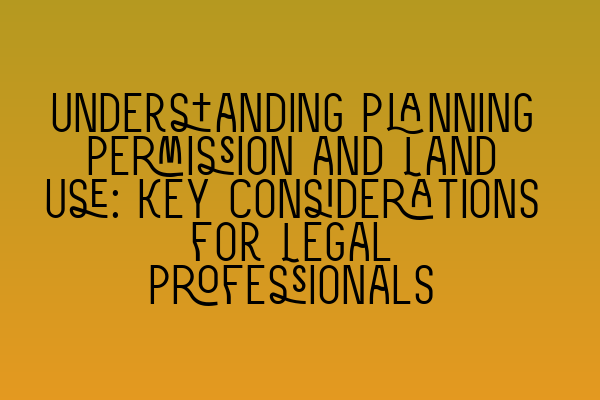Understanding Planning Permission and Land Use: Key Considerations for Legal Professionals
Introduction:
As legal professionals specializing in property law and land law, it is crucial to have a comprehensive understanding of planning permission and land use. Planning permission plays a pivotal role in determining the development and use of land, and as legal experts, it is our responsibility to guide our clients through the complex web of regulations and policies.
In this blog post, we will delve into the key considerations surrounding planning permission and land use, equipping you with the knowledge and insights necessary to navigate this crucial aspect of property law.
1. What is Planning Permission?
Planning permission is a crucial requirement for any property development or change in land use. It is a formal consent granted by the local planning authority, usually a local council, that determines whether a proposed development aligns with the established planning policies and regulations.
2. Types of Planning Permission:
There are several types of planning permission that legal professionals should be aware of:
– Full planning permission: This grants consent for the proposed development to proceed as planned.
– Outline planning permission: This provides initial approval for a proposed development, but the detailed design plans are to be submitted at a later stage.
– Reserved matters: When outline planning permission is granted, this refers to the specific details and aspects of the development that still need approval.
– Listed building consent: This is a form of planning permission that focuses specifically on the preservation and alteration of listed buildings.
3. Factors Influencing Planning Permission:
When advising your clients on planning permission, it is crucial to consider the following key factors:
a. Local Development Plan: The Local Development Plan (LDP) sets out the policies and guidelines for land use in a specific area. Familiarize yourself with the relevant LDP and its policies to ensure compliance.
b. Site Location: The location of the proposed development plays a significant role in obtaining planning permission. Consider the surrounding amenities, transport links, and the impact the development may have on the existing community.
c. Environmental Impact: Assess the environmental impact of the development, including its effect on biodiversity, landscape, and natural habitats. Adequate mitigation measures should be proposed.
d. Infrastructure and Services: Ensure that the necessary infrastructure and services, such as water supply, drainage, and access, are available and capable of supporting the development.
4. Land Use Considerations:
Understanding land use is paramount in the realm of planning permission. As legal professionals, we should be well-versed in the different classifications of land use, such as:
a. Residential: This refers to land or properties primarily used for housing purposes. It includes various sub-categories, such as single-family homes, apartments, and affordable housing.
b. Commercial: Land designated for commercial use encompasses properties used for retail, office spaces, and industrial purposes. It is essential to consider factors such as the impact on the local economy, traffic congestion, and noise pollution.
c. Agricultural: Land used for farming or agricultural purposes falls under this category. Considerations include the productivity of the land, access to essential agricultural resources, and compliance with environmental regulations.
d. Conservation: Certain areas may be designated as conservation areas, aiming to protect and preserve their historical, architectural, or cultural significance. Obtaining planning permission in conservation areas may have additional restrictions.
5. Engaging with Local Planning Authorities and Stakeholders:
Successful navigation of planning permission and land use issues often involves engaging with local planning authorities and stakeholders. Legal professionals should adopt a proactive approach by:
a. Building relationships with local planning authorities: Establishing a good working relationship with local planning authorities can facilitate smoother communication and ensure a more efficient process.
b. Conducting thorough research: Conducting thorough research on the local area, policies, and previous planning applications can provide valuable insights when engaging with stakeholders.
c. Communicating effectively: Clearly presenting the proposed development’s merits and addressing any concerns raised by local planning authorities and stakeholders is critical to achieving a favorable outcome.
d. Seeking expert advice: Where necessary, consult and collaborate with other professionals, such as architects, surveyors, and environmental consultants, to ensure the proposal is both legally compliant and sustainable.
Conclusion:
Understanding planning permission and land use is an essential skillset for legal professionals specializing in property law and land law. By considering the key factors influencing planning permission, gaining insights into different land use classifications, and engaging effectively with local planning authorities and stakeholders, we can provide expert advice and guide our clients through the complexities of property development.
At SQE Property Law & Land Law, we have a team of experienced solicitors who possess the expertise to navigate the intricacies of planning permission and land use regulations. Contact us today to discuss your property law needs and ensure a smooth and successful journey in the realm of planning permission.
Related Articles:
– Unraveling the Complexities of UK Bail Laws
– Remand in Custody: Understanding Detention Prior to Trial
– Appeals in Criminal Law: A Roadmap to Seeking Justice
– Exclusion of Evidence: Understanding Grounds and Implications
– Understanding Sentencing Guidelines in UK Criminal Cases
